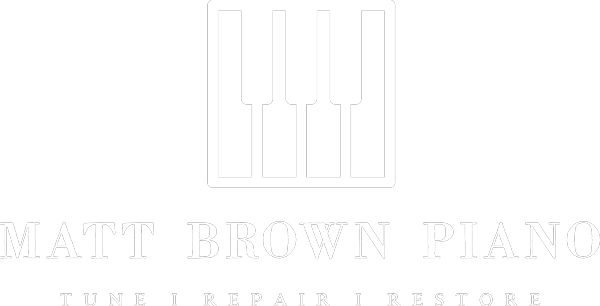Call Today to Schedule a service (480) 236-7145
Services
Piano Tuning
Regular use and humidity changes cause the strings in your piano to stretch and the piano to go out of tune. Using aural tuning methods, Matt will ensure that your piano sounds its best. Pianos that are tuned regularly stay in better condition and maintain their value. Matt recommends having your piano tuned every six months in order to maintain your strings as long as possible and avoid more costly repairs.
Piano Repair and Cleaning
Pianos that have not been properly maintained may need reconditioning or rebuilding prior to bring them back to playable condition. Reconditioning puts your piano back in good condition through cleaning, repair, and adjustment of your instrument, replacing parts only where specifically indicated. But, if your piano has deteriorated beyond simple reconditioning and repair, it may need to be rebuilt. Rebuilding involves complete disassembly, inspection and repair as necessary with replacement of all worn or deteriorated parts. Your piano is then reassembled, tested and adjusted to perform as when it was new.
Voicing
Piano voicing is the adjustment of your piano's tone or sound quality by adjusting the hardness of the hammers striking the string to produce a warmer or brighter tone. A skilled piano technician will work to make each hammer to work like the others to create the optimal tone, changing it from mellow to bright or robust to delicate. The amount of change possible depends upon your piano's design and condition.
New Hammer Installation
The piano hammer is the head of the action which strikes the string to create a vibration which makes the sound. Hammers are primarily made of wood and felt. Piano hammers may need to be replaced for the following reasons: they may be worn or damaged, a different tone quality is desired, hammers can no longer be voiced as desired, or as part of restoration.
Action Regulation
Piano tuning is the adjustment of the strings and pins in your piano to determine the pitch of each string. Action regulation is the adjustment of the mechanical aspects of your piano to compensate for the effects of wear and use. The intensity of the playing, the number of hours played, and the climactic conditions will determine how often regulation is necessary for your piano.
Regular use and humidity changes cause the strings in your piano to stretch and the piano to go out of tune. Using aural tuning methods, Matt will ensure that your piano sounds its best. Pianos that are tuned regularly stay in better condition and maintain their value. Matt recommends having your piano tuned every six months in order to maintain your strings as long as possible and avoid more costly repairs.
Piano Repair and Cleaning
Pianos that have not been properly maintained may need reconditioning or rebuilding prior to bring them back to playable condition. Reconditioning puts your piano back in good condition through cleaning, repair, and adjustment of your instrument, replacing parts only where specifically indicated. But, if your piano has deteriorated beyond simple reconditioning and repair, it may need to be rebuilt. Rebuilding involves complete disassembly, inspection and repair as necessary with replacement of all worn or deteriorated parts. Your piano is then reassembled, tested and adjusted to perform as when it was new.
Voicing
Piano voicing is the adjustment of your piano's tone or sound quality by adjusting the hardness of the hammers striking the string to produce a warmer or brighter tone. A skilled piano technician will work to make each hammer to work like the others to create the optimal tone, changing it from mellow to bright or robust to delicate. The amount of change possible depends upon your piano's design and condition.
New Hammer Installation
The piano hammer is the head of the action which strikes the string to create a vibration which makes the sound. Hammers are primarily made of wood and felt. Piano hammers may need to be replaced for the following reasons: they may be worn or damaged, a different tone quality is desired, hammers can no longer be voiced as desired, or as part of restoration.
Action Regulation
Piano tuning is the adjustment of the strings and pins in your piano to determine the pitch of each string. Action regulation is the adjustment of the mechanical aspects of your piano to compensate for the effects of wear and use. The intensity of the playing, the number of hours played, and the climactic conditions will determine how often regulation is necessary for your piano.
